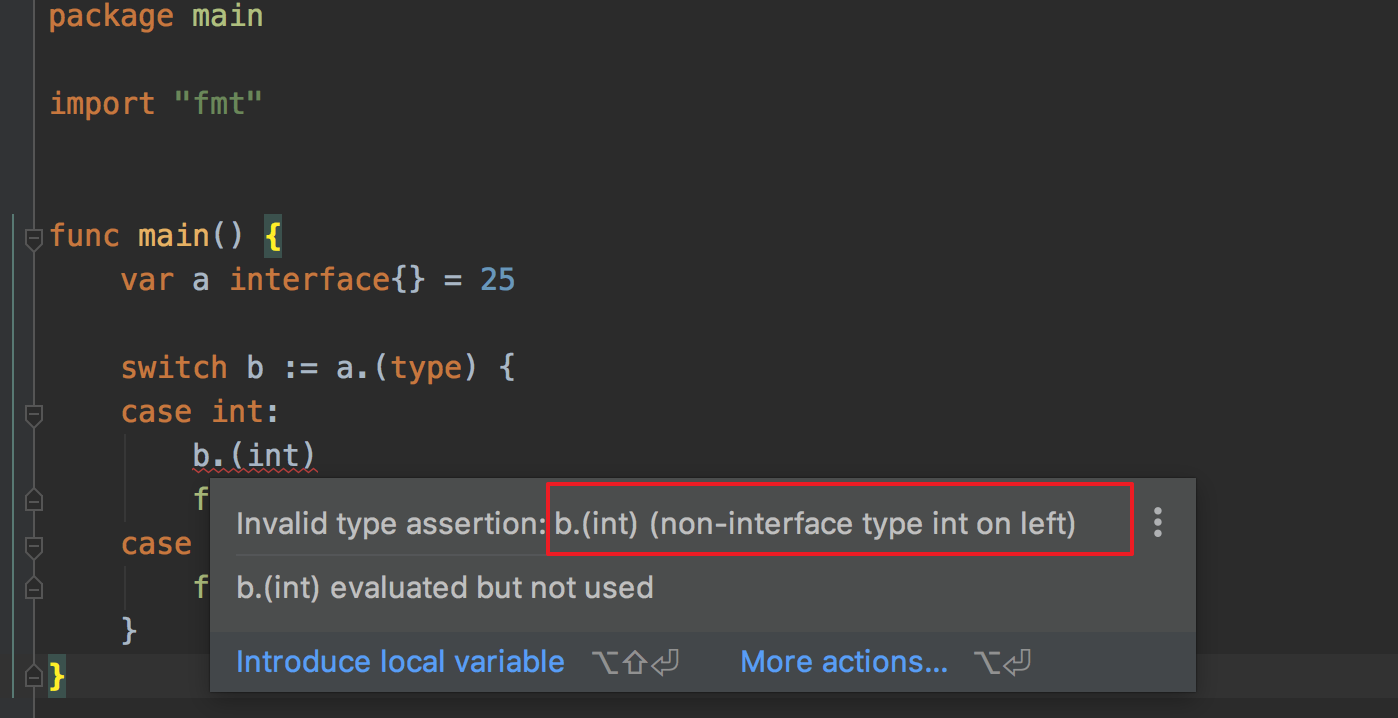
在线博客:http://golang.iswbm.com/
Github:https://github.com/iswbm/GolangCodingTime
---
## 1. 对方法的调用限制
接口是一组固定的方法集,由于静态类型的限制,接口变量有时仅能调用其中特定的一些方法。
请看下面这段代码
```go
package main
import "fmt"
type Phone interface {
call()
}
type iPhone struct {
name string
}
func (phone iPhone)call() {
fmt.Println("Hello, iPhone.")
}
func (phone iPhone)send_wechat() {
fmt.Println("Hello, Wechat.")
}
func main() {
var phone Phone
phone = iPhone{name:"ming's iphone"}
phone.call()
phone.send_wechat()
}
```
我定义了一个 Phone 的接口,只要求实现 call 方法即可,也就是只要能打电话的设备就是一个电话(好像是一句没用的废话)。
然后再定义了一个 iPhone 的结构体,该结构体接收两个方法,一个是打电话( call 函数),一个是发微信(send_wechat 函数)。
最后一步是关键,我们定义了一个 Phone 接口类型的 phone 对象,该对象的内容是 iPhone 结构体。然后我们调用该对象的 call 方法,一切正常。
但是当你调用 `phone.send_wechat `方法,程序会报错,提示我们 Phone 类型的方法没有 send_wechat 的字段或方法。
```go
# command-line-arguments
./demo.go:30:10: phone.send_wechat undefined (type Phone has no field or method send_wechat)
```
原因也很明显,因为我们的phone对象显示声明为 Phone 接口类型,因此 phone调用的方法会受到此接口的限制。
**那么如何让 phone 可以调用 send_wechat 方法呢?**
答案是可以不显示的声明为 Phone接口类型 ,但要清楚 phone 对象实际上是隐式的实现了 Phone 接口,如此一来,方法的调用就不会受到接口类型的约束。
修改 main 方法成如下
```go
func main() {
phone := iPhone{name:"ming's iphone"}
phone.call()
phone.send_wechat()
}
```
运行后,一切正常,没有报错。
```go
Hello, iPhone.
Hello, Wechat.
```
## 2. 调用函数时的隐式转换
Go 语言中的函数调用都是值传递的,变量会在方法调用前进行类型转换。
比如下面这段代码
```go
import (
"fmt"
)
func printType(i interface{}) {
switch i.(type) {
case int:
fmt.Println("参数的类型是 int")
case string:
fmt.Println("参数的类型是 string")
}
}
func main() {
a := 10
printType(a)
}
```
如果你运行后,会发现一切都很正常
```go
参数的类型是 int
```
但是如果你把函数内的内容搬到到外面来
```go
package main
import "fmt"
func main() {
a := 10
switch a.(type) {
case int:
fmt.Println("参数的类型是 int")
case string:
fmt.Println("参数的类型是 string")
}
}
```
就会有意想不到的结果,居然报错了。
```go
# command-line-arguments
./demo.go:9:5: cannot type switch on non-interface value a (type int)
```
这个操作会让一个新人摸不着头脑,代码逻辑都是一样的,为什么一个不会报错,一个会报错呢?
原因其实很简单。
当一个函数接口 interface{} 空接口类型时,我们说它可以接收什么任意类型的参数(江湖上称之为无招胜有招)。
当你使用这种写法时,Go 会默默地为我们做一件事,就是把传入函数的参数值(注意:Go 语言中的函数调用都是值传递的)的类型隐式的转换成 interface{} 类型。
### 如何进行接口类型的显示转换
上面了解了函数中 接口类型的隐式转换后,你的心里可能开始有了疑问了,难道我使用类型断言,只能通过一个接收空接口类型的函数才能实现吗?
答案当然是 No.
如果你想手动对其进行类型转换,可以像下面这样子,就可以将变量 a 的静态类型转换为 interface{} 类型然后赋值给 b (此时 a 的静态类型还是 int,而 b 的静态类型为 interface{})
```go
var a int = 25
b := interface{}(a)
```
知道了方法后,将代码修改成如下:
```go
package main
import "fmt"
func main() {
a := 10
switch interface{}(a).(type) {
case int:
fmt.Println("参数的类型是 int")
case string:
fmt.Println("参数的类型是 string")
}
}
```
运行后,一切正常。
```go
参数的类型是 int
```
## 3. 类型断言中的隐式转换
上面我们知道了,只有静态类型为接口类型的对象才可以进行类型断言。
而当类型断言完成后,会返回一个静态类型为你断言的类型的对象,也就是说,当我们使用了类型断言,Go 实际上又会默认为我们进行了一次隐式的类型转换。
验证方法也很简单,使用完一次类型断言后,对返回的对象再一次使用类型断言,Goland 立马就会提示我们新对象 b 不是一个接口类型的对象,不允许进行类型断言。

## 系列导读
---
[从零学习 Go 语言(01):一文搞定开发环境的搭建](https://studygolang.com/articles/27365)
[从零学习 Go 语言(02):学习五种变量创建的方法](https://studygolang.com/articles/27432)
[从零学习 Go 语言(03):数据类型之整型与浮点型](https://studygolang.com/articles/27440)
[从零学习 Go 语言(04):byte、rune与字符串](https://studygolang.com/articles/27463)
[从零学习 Go 语言(05):数据类型之数组与切片](https://studygolang.com/articles/27508)
[从零学习 Go 语言(06):数据类型之字典与布尔类型](https://studygolang.com/articles/27563)
[从零学习 Go 语言(07):数据类型之指针](https://studygolang.com/articles/27585)
[从零学习 Go 语言(08):流程控制之if-else](https://studygolang.com/articles/27613)
[从零学习 Go 语言(09):流程控制之switch-case](https://studygolang.com/articles/27660)
[从零学习 Go 语言(10):流程控制之for 循环](https://studygolang.com/articles/28120)
[从零学习 Go 语言(11):goto 无条件跳转](https://studygolang.com/articles/28472)
[从零学习 Go 语言(12):流程控制之defer 延迟语句](https://studygolang.com/articles/28515)
[从零学习 Go 语言(13):异常机制 panic 和 recover](https://studygolang.com/articles/28519)
[从零学习 Go 语言(14):Go 语言中的类型断言是什么?](https://studygolang.com/articles/29305)
[从零学习 Go 语言(15):学习 Go 语言的结构体与继承](https://studygolang.com/articles/29306)
[从零学习 Go 语言(17):Go 语言中的 make 和 new 有什么区别?](https://studygolang.com/articles/29315)
[从零学习 Go 语言(18):Go 语言中的 语句块与作用域](https://studygolang.com/articles/29365)
[从零学习 Go 语言(19):Go Modules 前世今生及入门使用](https://studygolang.com/articles/29371)
[从零学习 Go 语言(20):关于包导入必学的 8 个知识点](https://studygolang.com/articles/29404)
[从零学习 Go 语言(21):一文了解 Go语言中编码规范](https://studygolang.com/articles/29477)
[从零学习 Go 语言(22):Go 语言中如何开源自己写的包给别人用?](https://studygolang.com/articles/29609)
[从零学习 Go 语言(23):一篇文章搞懂 Go 语言的函数](https://studygolang.com/articles/29628)
[从零学习 Go 语言(24):理解 Go 语言中的 goroutine](https://studygolang.com/articles/29641)
[从零学习 Go 语言(25):详解信道/通道](https://studygolang.com/articles/29704)
[从零学习 Go 语言(26):通道死锁经典错误案例详解](https://studygolang.com/articles/29756)
[从零学习 Go 语言(27):学习 Go 协程中的 WaitGroup](https://studygolang.com/articles/29783)
[从零学习 Go 语言(28):学习 Go 协程中的互斥锁和读写锁](https://studygolang.com/articles/29838)
[从零学习 Go 语言(29):Go 语言中的 select 用法](https://studygolang.com/articles/29852)
[从零学习 Go 语言(30):如何使用 GDB 调试 Go 程序?](https://studygolang.com/articles/29867)
[从零学习 Go 语言(31):Go 语言里的空接口](https://studygolang.com/articles/29885)
[从零学习 Go 语言(32):理解 Go 语言中的 Context](https://studygolang.com/articles/29900)
[从零学习 Go 语言(33):如何手动实现一个协程池?](https://studygolang.com/articles/29943)
---

有疑问加站长微信联系(非本文作者))





